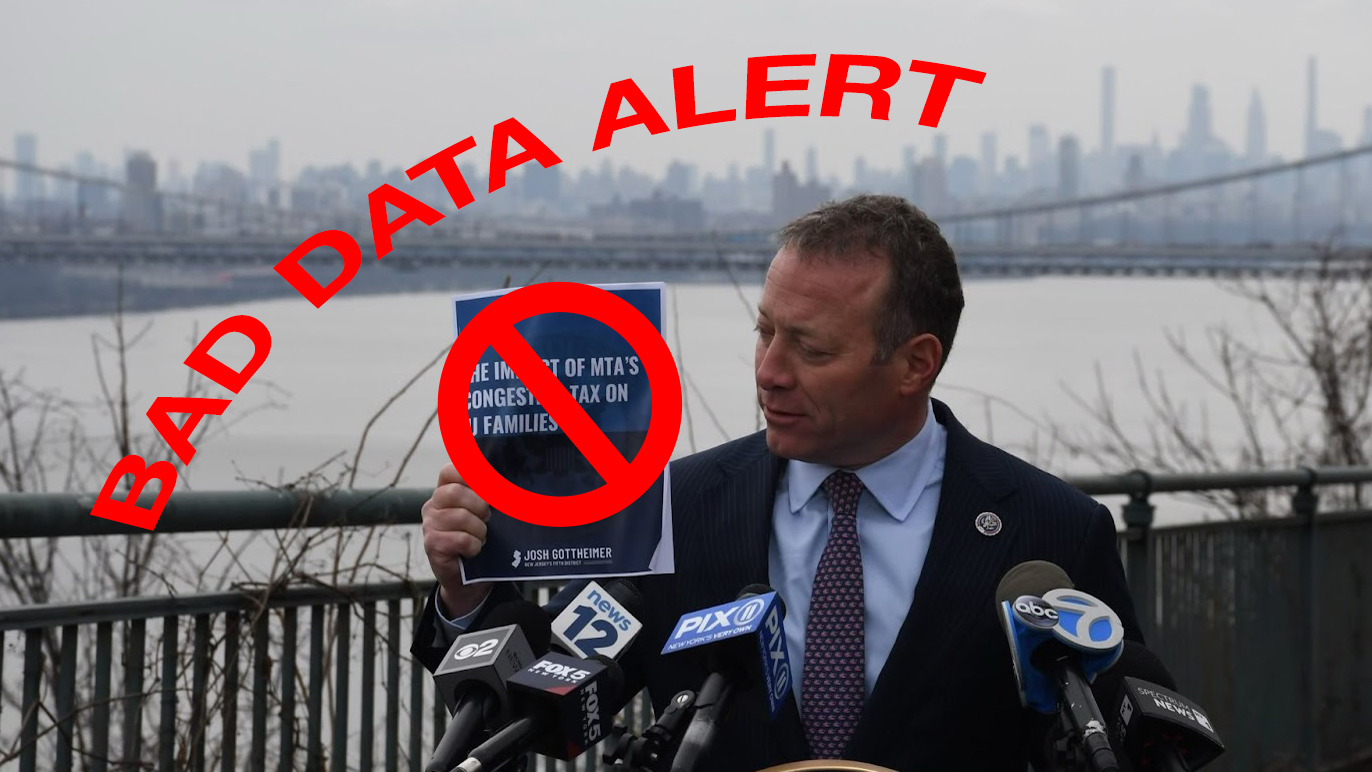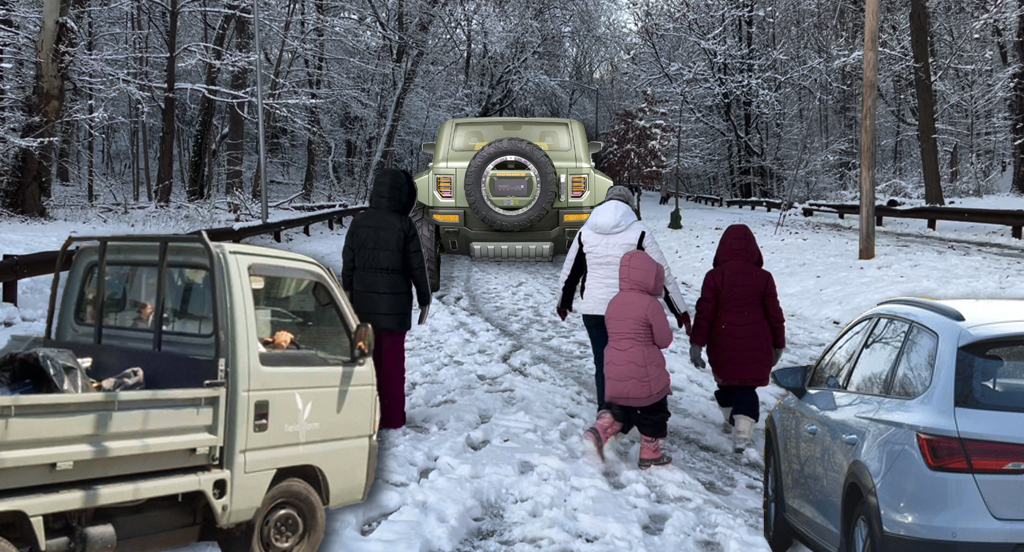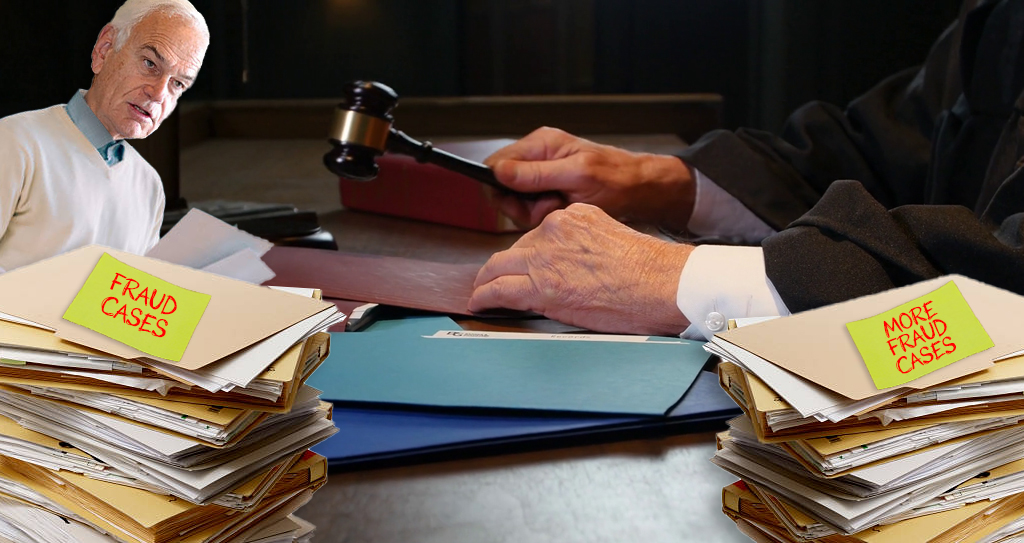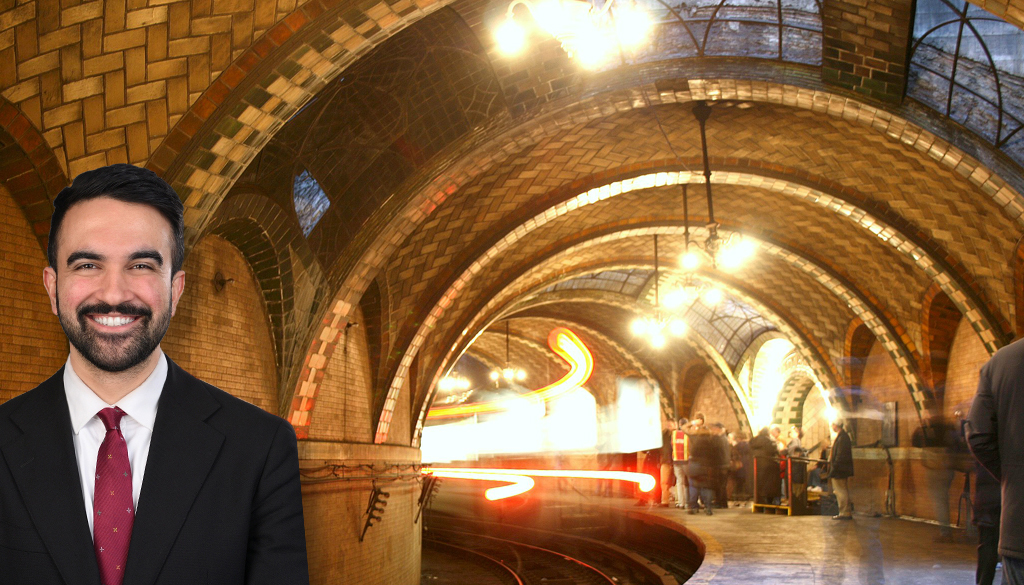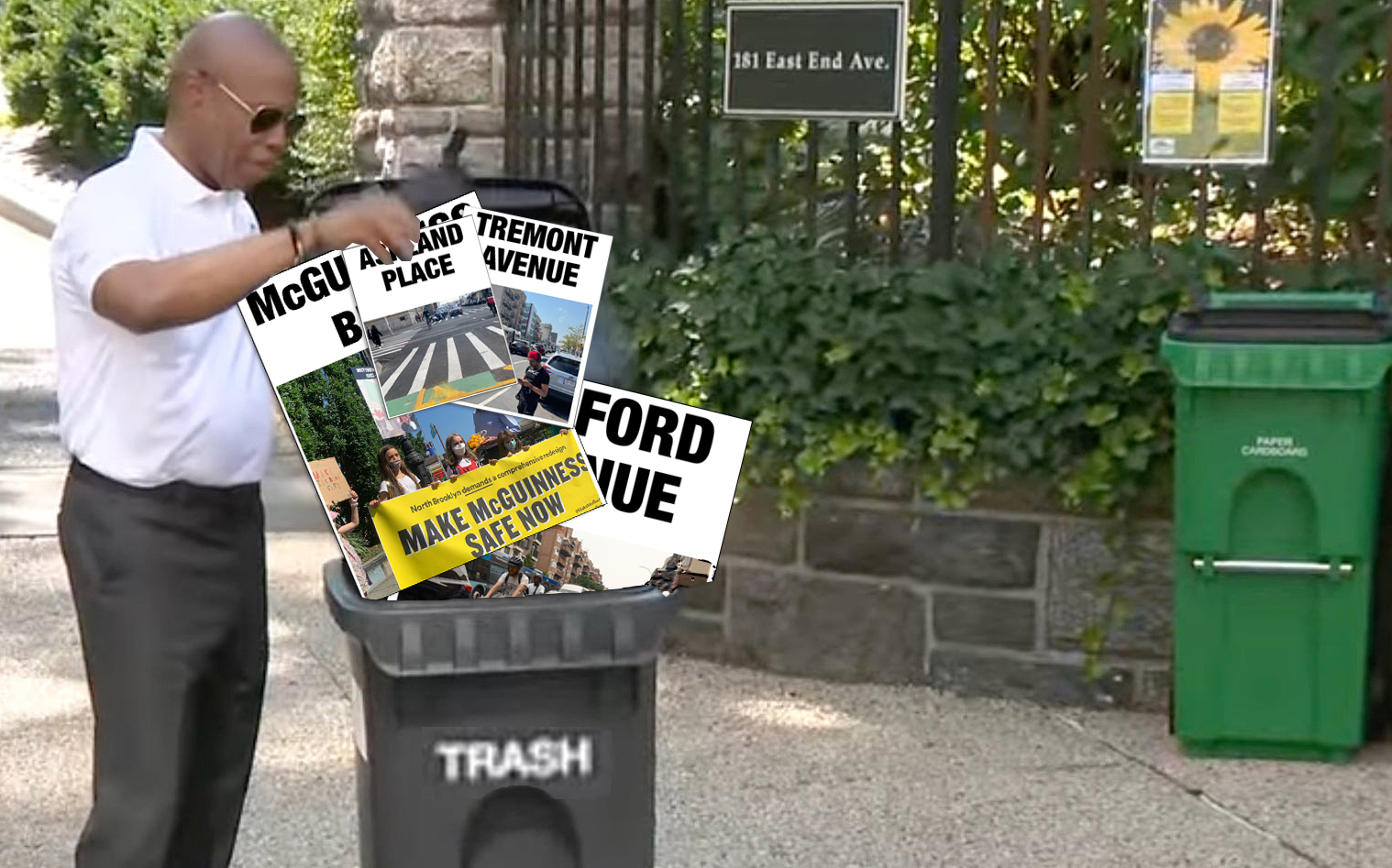A "bombshell report" from U.S. Rep. Josh Gottheimer (D-New Jersey) shows that the longtime foe of congestion pricing needs to learn a thing or two about the policies he's fighting — as his latest argument that the MTA will raise "too much money" from the traffic toll suffers from egregiously poor math.
Gottheimer claimed in a recent report that the MTA will raise $3.4 billion per year under congestion pricing when it finally begins — over three times the legally mandated amount of $1 billion per year. But rather than celebrate the possibility of raising more than triple the expected amount for the city's crippling transit system, Gottheimer has spent the last week huffing and puffing about the expected "excess revenue generation" that his math allegedly reveals.
Since the release of the report a week ago, Gottheimer has been crowing about how he "ran the numbers." But a closer look at the analysis shows he did more of a fun run than a marathon — and that the Democrat does not understand anything about congestion pricing or the world of forecasting traffic patterns.
We ran the numbers — there’s no reason Jersey drivers can’t be exempt from the Congestion Tax.
— Rep Josh Gottheimer (@RepJoshG) January 9, 2024
After years of mismanagement, the MTA is a hot mess and just desperate for cash — even if that means taking it from hardworking Jersey families.https://t.co/QtytHjYse5
To get to his $3.4 billion figure, Gottheimer did a back-of-the-envelope calculation of what he said was the existing traffic coming into lower Manhattan, and subtracted the amount transit officials expect traffic to drop once the $15 toll launches. That meant taking the figure of 900,000 vehicles per day that the Traffic Mobility Review Board said enter the CBD every day and cutting it by 17 percent — leaving 747,000 vehicles.
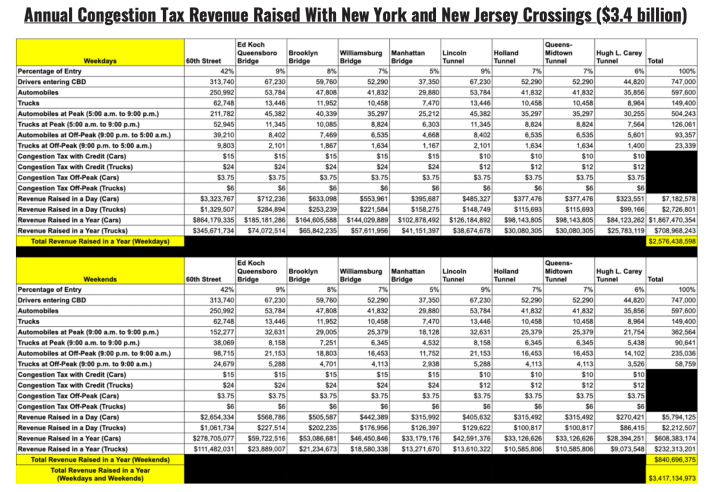
Gottheimer then broke the vehicle entires down further into cars or trucks, tried to predict the percentage of trips into lower Manhattan from the various crossings into the area, and tolled the vehicles accordingly. For weekends, he predicted the same amount of traffic at all times and simply added up his daily toll figures for two days instead of five days.
That, to put it plainly, is not how any of this works.
Gottheimer's first mistake was to not double-check the MTA. His figure of 900,000 vehicles entering the Central Business District each day comes from the TMRB's own report. That figure supposedly comes from the New York Metropolitan Transportation Council Hub Bound Travel Data 2021 Report, per a footnote in the TMRB report.
However, the TMRB messed up — because the number of vehicles that entered the central business district on an average day in 2021 was just 605,756 private cars, trucks, vans, taxis and buses. The number of people who entered lower Manhattan every day in those vehicles though, was 893,452 people. According to a source with knowledge of the TMRB process, the offending graphic was supposed to read "900,000 people in vehicles enter the CBD every weekday."
After Streetsblog raised the issue, the MTA corrected the online edition of the TMRB report, but screenshots of both versions are included below:
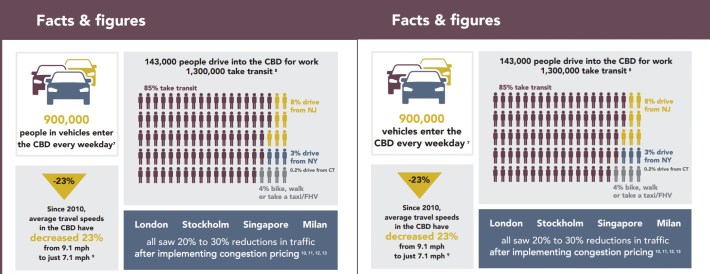
Gottheimer could have avoided this initial error if he'd followed the footnote to the NYMTC report or if someone in his office had thought about the issue more critically. But the logic underpinning his argument still falls apart — on several counts — even after correcting for the MTA's error.
"There was no single error or flub in what Gottheimer did," said Charles Komanoff, a transportation economist and longtime scholar of congestion pricing. "There are at least eight factors he got wrong."
Among those, according to Komanoff, were the following:
- Taxis and for-hire vehicles aren't separated from cars in Gottheimer's calculations — despite the fact that the vehicles themselves will not be tolled when entering the CBD, resulting in an overcount of 95,000 cars alone.
- Gottheimer "neglected to net the return legs of 'through trips' (for example, a New Jersey-to-Brooklyn trip that enters the zone in the morning via a Hudson River tunnel and returns later via an East River bridge). The Hub-Bound data count this as two trips, but per the 2019 legislation the vehicle is tolled only once." That accounts for at least 50,000 overcounted trips, Komanoff said.
- Another 35,000 vehicle trips included in Gottheimer's numbers wouldn't be tolled because they either come from the north and don't get off the highway, or pass 60th Street from the south by coming up the FDR Drive from Brooklyn.
- Gottheimer suggests trucks will account for 20 percent of traffic entering lower Manhattan, but Komanoff (who, again, has studied this issue for decades and has a frequently updated spreadsheet forecasting what the impact of the toll is supposed to be) believes truck traffic will only be 12 percent of total traffic. Due to the higher toll on trucks, the revenue forecast in Gottheimer's report is too high by about 7 percent, he said.
- Gottheimer makes the assumption that every dollar of the toll will be collected, rather than the MTA missing some due to toll evasion — which Komanoff predicts will include about 25,000 vehicles per day that escape the charge.
- The Gottheimer math also doesn't include the MTA's discount program that cuts the toll by 50 percent for low-income drivers after they make 10 trips into lower Manhattan in a month.
- Gottheimer's report assumed that traffic is the exact same on weekends as it is on weekdays, but traffic generally drops by about 12 percent on weekends, which adds 4 percent extra to Gottheimer's vehicle and revenue projections.
- And finally, Gottheimer leaves out the money spent on actually administering the tolls, which Komanoff pegs at about $110 million.
Ultimately, Komanoff predicts that about 400,000 daily vehicles will wind up paying the toll — a far cry from the 747,000 that Gottheimer trumpeted.
A spokesperson for the MTA — the agency that at least in part contributed to Gottheimer's bad math — criticized what the agency said was the omission of trips that were expected to switch to transit. Per the MTA's environmental review of the program, depending on the toll scenarios studied, NJ Transit could pick up 2 percent more riders on trains and 1 percent more bus riders into lower Manhattan. The PATH train could see a 2 percent ridership bump as well.
"Gridlock Gottheimer’s math is a joke. In his pro-traffic math world, he’s even calculating a toll for drivers that would do the right thing and switch to mass transit, no longer congesting City streets," said MTA Chief of Policy and External Relations John McCarthy.
"It’s scary for Americans that this congestion-loving politician—who serves on the Financial Services committee in the United States Congress—clearly can’t count."
There is a silver lining in Gottheimer's swing and a miss: His attempt at simple math in a nine-page report showed just how much work goes into the kind of traffic modeling and air quality forecasts that make up the MTA's 4,000-page environmental assessment of the proposed toll, which took several years.
"In a sense, what it comes down to is that you've got to let the professionals do this. And he's an amateur," said Komanoff.
Other congestion pricing supporters were less kind.
"The report issued by Rep. Gottheimer is nonsense," said Reinvent Albany Senior Policy Advisor Rachael Fauss. "Any real analysis of the revenue would be issued by an independent authority like the NYC Independent Budget Office, not cooked up in-house by someone with a vested interest in undermining New York's ability to combat the real costs of congestion and pollution on its streets."
While noting that three-quarters of Bergen County commuters to lower Manhattan get there via public transit, former city DOT official Jon Orcutt blasted Gottheimer for choosing a wealthy car commuter minority in his own district even over public transit users he's also paid to represent.
"Despite its title, Rep. Gottheimer's report is fact-free about actual New Jersey families. The reality is only a tiny share of Bergen County residents car commute to Manhattan," said Orcutt, who seved in the Bloomberg and de Blasio administrations.
"I guess we shouldn't be surprised with this coming from a leader of the political class that has failed for a generation to deliver the Bergen element of the Hudson-Bergen transit system. But you'd expect better math, logic and project delivery from a self-styled Problem Solver."
